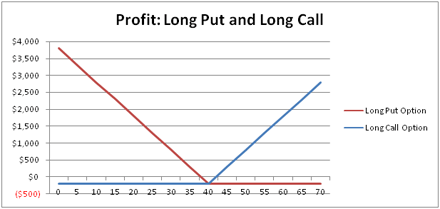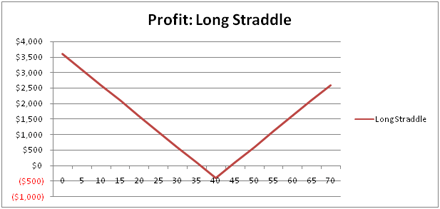Business Finance
Investment Strategies: Straddles
Written by Gregory Steffens for Gaebler Ventures
Many equity investment strategies utilize both call and put options to decrease the amount of risk investors face with their investment portfolios. One such strategy involves straddles that use calls and puts to capitalize on volatile stock prices.
Interested in learning about derivatives and their role in the business world?
This article will introduce the hedging strategy of straddles, how they are created, and how investors profit from their design.
Straddle
A straddle is an option strategy involving the purchase of a put and call option with the same exercise price on an individual stock. Investors who anticipate high volatility with an individual stock use straddles to profit from the large price swings.
Because they combine the profit potentials of both call and put options, straddles benefit from any movement away from the strike price. Below, the profit profile for a long call option and a long put option are shown.

By combining the put and call option, one can see the profit profile for a straddle. To pursue this strategy, investors must purchase two options with two option premiums. Therefore, the most investors can lose involves the total amount of these two premiums.
The stock price must increase or decrease enough to recoup this initial investment before investors can realize a profit. Their design limits potential losses to a relatively small amount while offering large to limitless potential profits.
Because of this design, straddles are used by investors who anticipate a stock's value to vary greatly during the lives of the options but do not have strong feelings one way or the other on the direction. An investor that wants to lean one way or the other should consider creating a strap or a strip.
In the below example, a call and a put options with a $40 strike price and the same expiration date are written on a 100 shares of stock. Because each of the options demanded a $200 premium, the strategy begins out-of-the-money $400. However, any deviation in the stock price away from the $40 exercise price benefits the investor.
This results in having two break-even points for the investment. The stock's value must fall to $36 or increase to $44 before the investor realizes any profits. Since the stock price can only decrease to zero, the downside profit potential is limited to $3,600, while the upside profit potential is unlimited because the stock can rise indefinitely.

Gregory Steffens is a talented writer with a strong interest in business strategy and strategic management. He is currently completing his MBA degree, with an emphasis in finance, at the University of Missouri.
Share this article
Additional Resources for Entrepreneurs






Conversation Board
Help us out by offering your comments, tips, questions or suggestions regarding this article on investment strategies and option straddles.